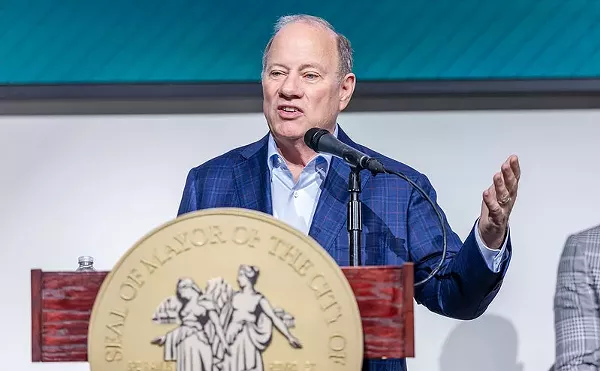
Audio By Carbonatix
[
{
"name": "GPT - Leaderboard - Inline - Content",
"component": "35519556",
"insertPoint": "5th",
"startingPoint": "3",
"requiredCountToDisplay": "3",
"maxInsertions": 100,
"adList": [
{
"adPreset": "LeaderboardInline"
}
]
}
]
How to Be a Man
How to Be a Woman
Kino
Often, the funniest jabs in Mystery Science Theater 3000 came not at the expense of the feature-length sci-fi turkeys Joel, Mike and the 'bots were so mercilessly fed, but at the unintentionally hilarious educational shorts that preceded them. These short movies, full of horrible acting, histrionically excessive scores, and authoritative voice-overs, usually had one of two purposes: teaching young people about their changing bodies or their economic futures, or scaring the bejesus out of them with blunt morality tales. Think Reefer Madness but in 8-, 15- and 30-minute servings.
Skip Elsheimer, founder of the impressive archive A/V Geeks, has collected some 23,000 of these shorts, 27 of which can be found on Kino's new How to Be a Man and How to Be a Woman discs. Elsheimer spreads his love for these shorts in supplements on both DVDs, and indeed, there is a lot of value here. Looking at them now provides a revealing glimpse at the elements of perceived social instability in the '50s and '60s.
The subject matter ranges from the life-altering (when to get married) to the quotidian (how to make a fish sandwich), but they all have the same ingredients. The prints are rife with inoperable splices and tears, the shorts feature actors seemingly plucked off the street, whose superfluous close-ups are chockablock with dermatological terror and whose voices suggest bizarre speech disorders.
The content of many of these movies is even more frightening. For women, the fear-mongering begins at puberty, depicted as a veritable monthly prison in 1955's "You're Growing Up." Who knew girls on their periods had to keep their feet dry, or that bathing or washing hair could be potentially unacceptable during those four to five dreadful days? Later in life, they're encouraged to take home economics courses (in "Why Study Home Economics?" from 1955, and "Pattern for Smartness" from 1948), which teach young girls how to be perfect homemakers and indentured Stepford wives. Even cooking is seen as a self-sacrificing gesture — the female chef makes the tuna sandwiches for her male companions, leaving nothing for herself. ("Let's Make a Sandwich," from 1950, includes classic lines such as "Mother is a great believer in the aesthetic value of parsley.")
And sex? Obviously, it's for procreation only — don't dare get hitched in high school just to get some nookie. In 1962's despicable "Worth Waiting For," tellingly produced by Brigham Young University, two high-schoolers consider marriage — with the implicit suggestion that they'll finally get to consummate their love — only to find they must endure their parents' shame and succumb to a life of wailing babies and shattered dreams.
For guys, it's assumed their status quo is committing juvenile, criminal or lascivious behavior, and that these shorts will steer inchoate delinquents onto the right path. Looking at these shorts, it's quite obvious men developed from primates.
"The Show-Off," from 1954, depicts a boorish class clown who gets his comeuppance after sneakily hanging a sign reading "Yea, Juniors" on the school building — not a sign of school pride, according to the filmmakers, but an offensive affront to human decency. "Car Theft," from '56, is even better (meaning much, much worse), showing three homoerotic youths stealing a car and running over a helpless little girl in a low-speed police chase.
You can't really blame the horridness of most of these films — their shocking naïve realizations of youth were based on ignorant societal stigmas that existed at the time. And no matter how damaging these films seemingly could be, you can always look back from our liberated modern times and laugh with pride. —John Thomason
Wizard of Oz: 70th Anniversary Ultimate Collector's Edition
Warner Bros.
It would take you days to go through everything on this gorgeous Blu-ray set: the books, the archival material, the extras (including silent-movie versions of Oz) and of course the film classic, making its high-def debut. The scene where Dorothy first steps into Oz now bursts with splendor. Plus, the flying monkeys are super-creepy in HD. —Michael Gallucci
Requiem for a Dream
Lionsgate
One of the best movies of the decade, after Hubert Selby Jr.'s scarily brilliant novel, finally comes to Blu-ray. It features deleted scenes, a making-of doc and commentary by director Darren Aronofsky (who helmed the equally excellent The Wrestler last year). The HD makes the story — about four people battling different forms of addiction — all the more harrowing. —Michael Gallucci
Munyurangabo
Film Movement
Amid poverty-stricken tableaux ripped from the pages of National Geographic, Lee Isaac Chung's vérité stunner Munyungabo looks ahead to Rwandan reconciliation by looking back at the country's horrific 1994 genocide. The malnourished title character (Jeff Rutagengwa) treks through the countryside, aiming to avenge his parents' genocidal deaths with a stolen machete. He finds a partner in the younger Sangwa (Eric Ndorunkundiye); problem is, Sangwa is a Hutu and Munyurangabo a Tutsi, the opposing Rwandan ethnic groups at the heart of the genocide. They may as well be Capulet and Montague or Sunni and Shia —the divide is universal, and the tearing apart of the friendship due to politics is tragically inevitable. Climaxing with a direct-to-camera slam poem about Rwandan injustice, Chung's masterpiece is nothing less than a slow-burning, ritualistic expose of a nation, shot through with enough physical distance, rhyming sequences and unpredictable camerawork to wow film theorists and ethnographers alike. —John Thomason





